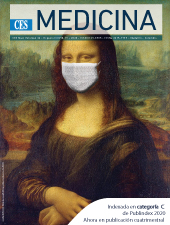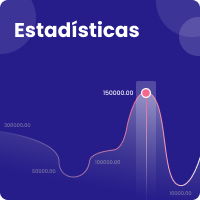Actividad física y ejercicio en tiempos de COVID-19
DOI:
https://doi.org/10.21615/cesmedicina.34.COVID-19.6Palabras clave:
Ejercicio, Pandemias, Cuarentena, Sistema inmunológico, COVID-19Resumen
La situación mundial generada por la actual pandemia del COVID-19 ha propuesto diversas estrategias para mitigar el impacto de esta enfermedad. Dentro de las disposiciones establecidas por la OMS se ha implementado el confinamiento y el distanciamiento social, generando un cambio abrupto en los hábitos y rutinas diarias de las personas, impactando la actividad física, el ejercicio y el deporte. Esta medida de restricción aumenta la exposición al sedentarismo, condición que inicia o deteriora una enfermedad crónica no transmisible previa e incrementa el riesgo de mortalidad por la pandemia. El ejercicio debe ser una estrategia a tener en cuenta en tiempo de cuarentena, con el fin de proteger la salud física y mental de las personas, mantener una condición física saludable y un buen rendimiento atlético, cumpliendo así, con los principios y lineamientos metodológicos de la prescripción del ejercicio y el entrenamiento. El objetivo de esta revisión de tema fue establecer la importancia de la actividad física y el ejercicio para el cuidado de la salud y el mantenimiento de la condición física en tiempos de confinamiento por COVID-19.
Descargas
Referencias bibliográficas
Trilla A. Un mundo, una salud: la epidemia por el nuevo coronavirus COVID-19. Med Clin (Barc). 2020; 154 (5):175-177. Disponible en: https://doi.org/10.1016/j.medcli.2020.02.002
Organización Mundial de la Salud. Brote de enfermedad por coronavirus (COVID-19): orientaciones para el público. [Sitio en internet]. Disponible en: URL https://www.who.int/es/emergencies/diseases/novel-coronavirus-2019/advice-for-public
Usher K, Bhullar N, Jackson D. Life in the pandemic: Social isolation and mental health. J Clin Nurs. 2020,00:1-2. Disponible en: https://doi.org/10.1111/jocn.15290.
Law S, Leung AW, Xu C. Severe acute respiratory síndrome (SARS) and coronavirus disease-2019 (COVID-19): From causes preventions in Hong Kong. Disponible en: https://doi.org/S1201-9712 (20)30192-2.
Heffernan K, Young S. Exercise as medicine for COVID-19: an ACE in the hole?. Med Hypotheses.2020;142: 1098035. Disponible en: https://doi.org/10.1016/j.mehy.2020.109835.
Booth FW, Roberts CK, Thyfault JP, Ruegsegger GN, Toedebusch RG. Role of inactivity in chronic diseases: Evolutionary insight and pathophysiological mechanisms. Physiol Rev. 2017; 97 (4): 1351-1402. Disponible en: https://doi.org/10.1152/physrev.00019.2016.
Chen P, Mao L, Nassis G, Hammer P, Ainsworth B, Fuzhing L. Coronaviruses disease (COVID-19): The need to mantein regular physical activity while taking precautions. J Sport Health Sci. 2020; 9 (2): 103-104. Disponible en: https://doi.org/10.1016/j.jshs.2020.02.001
Zhang S, Wang Y, Rauch A, Feng W. Unprecedented disruption of lives and work: Health, distrees and life satisfaction of working adults in China one month into the COVID-19 outbreak. Psychiatry Res. 2020;288: 112958. Disponible en: https://www.sciencedirect.com/science/article/pii/S0165178120306521
Carter SJ, Baranauskas MN, Fly AD. Considerations for obesity, vitamin D, and physical activity amidst the COVID-19 pandemic. Obesity (Silver Spring). 2020. Disponible en: https://doi.org/10.1002/oby.22838.
Haileamlak A. Physical Inactivity: The major risk factor for non-communicable diseases. Ethio J Health Sci. 2019; 29 (1): 810. Disponible en: https://doi.org/10.4314/ejhs.v29i1.1
Esain I, Gil SM, Bidaurrazaga- Letona I, Rodriguez- Larrad A. Effect of 3 months of detraining on functional fitness and quality of life in older adults who regularly exercise. Aging Cli Exp Res. 2019; 31 (4): 503-510. Disponible en: https://doi.org/10.1007/s40520-018-0990-1
Esain I, Rodriguez- Larrad A, Bidaurrazaga- Letona I, Gil SM. Health- related quality of life, handgrip strength and falls during detraining in elderly habitual exercisers. Health Qual Life Outcomes. 2017;15 (1): 226. Disponible en: https://doi.org/10.1186/s12955-017-0800-z.
Correa C, Cunha G, Marques N, Oliveira- Reischak A, Pinto R. Effects of strength training, detraining and retraining in muscle strength, hypertrophy and functional tasks in older female adults. Clin Physiol and Functional Imag. 2015. 36 (4): 306-310. Disponible en: https://doi.org/10.1111/cpf.12230.
Kalapotharakos VI, Diamantopoulos K, Tokmakidis SP. Effects of resistance training and detraining on muscle strength and funtional performance o folder adults aged 80 to 88 years. Aging Clin Exp Res. 2010; 22 (2): 134-40. Disponible en: https://doi.org/10.1007/bf03324786
Pecanha T, Goessler K, Roschel H, Gualano B. Social isolation during the COVID-19 pandemic can increase physical inactivity and the global burden of cardiovascular disease. Am J Physiol Heart Circ Physiol. 2020; 318: H1441-H1446. Disponible en: https://doi.org/10.1152/ajpheart.00268.2020
Jukic I, Calleja-González J, Cos F, Cuzzolin F, Olmo J, Terrados N. Strategies and solutions for teams sports athletes in isolation due to COVID-19. Sports (Basel). 2020; 8(4): 56. Disponible en: https://doi.org/10.3390/sports8040056
Suarez-Arrones L, Lara- Lopez P, Maldonado R, Torreno N, De Hoyo M, Nakamura FY, et al. The effects of detraining and retraining periods an fat mass and fat- free mass in elite male soccer players. Peer J. 2019; 7: e7466. Disponible en: https://doi.org/10.7717/peerj.7466.
Guerrero- Calderon B. The effect of short-term and long-term coronavirus quarantine on physical performance and injury incidence in high-level soccer. Soccer and Society.2020. Disponible en: https://doi.org/10.1080/14660970.2020.1772240
Wilkinson TJ, Shur NF, Smith AC. “Exercise as medicine” in chronic kidney disease. Scan J Med Sci Sports. 2016; 26 (8): 985-8. Disponible en: https://doi.org/10.1111/sms.12714
Hammami A, Harrabi B, Mohr M, Krustrup P. Physical activity and coronavirus disease 2019 (COVID-19): specific recommendations for home-based physical training. Managing Sports and Leisure. 2020. Disponible en: https://doi.org/10.1080/23750472.2020.1757494
Jurak G, Morrison S, Leskoek B, Kovac M, Hadzic V, Vodicar J, et al. Physical activity recommendations during the coronavirus disease-2019 virus outbreak. J Sport Health Sci. 2020. Disponible en: https://doi.org/10.1016/j.shs.2020.05.003
Weyh C, Kruger K, Strasser B. Physical activity and diet shape the immune system during aging. Nutrients 2020; 12 (3). Disponible en: https://doi.org/10.3390/nu12030622.
Xie Y, Wang JP. [Advance in effect of aerobic exercise on immune system and autoimmune diseases]. Sheng Li Xue Bao. 71 (5): 769-782. Disponible en: https://www.ncbi.nlm.nih.gov/pubmed/31646331
Zwetsloot K, John C. Lawrence M, Battista R, Shanley A. High-intensity Interval training induces a modest systemic inflammatory response in active, young men. J Inflamm Res. 2014; 7: 9-17. Disponible en: https://doi.org/10.2147/JIR.S54721
Monteiro PA, Campos EZ, de Oliveira FP, Peres FP, Rosa- Neto JC. Pimentel GD, et al. Modulation of inflammatory response arising from high. Intensity intermittent and concurrent strngth training in phisically active males. Cytokine. 2017; 91: 104-109. Disponible en: https://doi.org/10.1016/j.cyto.2016.12.007
Colegio Americano del Deporte. Manual ACSM para la valoración y prescripción del ejercicio 8va Edición. Editorial Paidotribo. 2019.
Physical exercise as therapy to fight against the mental and physical consequences of COVID-19 quarantine: Special focus in older people. Prog Cardiovasc Dis. 2020. Disponible en: https://doi.org/10.1016/j.pcad.2020.03.009
Rodriguez M, Crespo I, Olmedillas H. exercising in times of COVID-19: what do experts recommend doing within four walls?. Rev Esp Cardiol. 2020. Disponible en: http://doi.org/10.1016/j.recesp.2020.04.002
Bormann de Souza B, Fernandes E. COVID-19: the importance of new technologies for physical activity as a public health strategy. Cad Saúde Pública. 2020; 36(5): e00054420. Disponible en: http://doi.org/10.1590/0102-311X00054420
Subirats B, Subirats G, Soteras I. Prescripción del ejercicio físico: indicaciones, posología y efectos adversos. Med Clin. 2012; 138 (1): 18-24. Disponible en: http://doi.org/10.1016/j.medcli.2010.12.008
Chen P, Mao L, Nassis G, Harmer P, Ainsworth B, FuzHong L. Returning Chinese school-aged children and adolescents to physical activity in the wake of COVID-19: actions and precautions. J Sport Health Sci. 2020: 1-3. Disponible en: http://doi.org/10.1016/j.shs.2020.04.003
Woods J, Hutchinson N, Powers S, Roberts W, Gomez-Cabrera M, Radak Z, et al. The Covid-19 Pandemic and physical activity, Sports Med Health Sci. 2020. Disponible en: http://doi.org/10.1016/j.smhs.2020.05.006
Primorac D, Matisic V, Molnar V, Bahtijarevic Z, Polasek O. Pre-season football preparation in the era of COVID-19: Croatian football association model. JoGH. 2020; 10(1): 010352. Disponible en: http://doi.org/10.7189/jogh.10.010352
Descargas
Publicado
Cómo citar
Número
Sección
Licencia
Derechos de autor 2020 CES Medicina

Esta obra está bajo una licencia internacional Creative Commons Atribución-NoComercial-CompartirIgual 4.0.
Derechos de reproducción (copyright)
Cada manuscrito se acompañará de una declaración en la que se especifique que los materiales son inéditos, que no han sido publicados anteriormente en formato impreso o electrónico y que no se presentarán a ningún otro medio antes de conocer la decisión de la revista. En todo caso, cualquier publicación anterior, sea en forma impresa o electrónica, deberá darse a conocer a la redacción por escrito.
Plagios, duplicaciones totales o parciales, traduccones del original a otro idioma son de responsabilidad exclusiva de los autores el envío.
Los autores adjuntarán una declaración firmada indicando que, si el manuscrito se acepta para su publicación, los derechos de reproducción son propiedad exclusiva de la Revista CES Medicina.
Se solicita a los autores que proporcionen la información completa acerca de cualquier beca o subvención recibida de una entidad comercial u otro grupo con intereses privados, u otro organismo, para costear parcial o totalmente el trabajo en que se basa el artículo.
Los autores tienen la responsabilidad de obtener los permisos necesarios para reproducir cualquier material protegido por derechos de reproducción. El manuscrito se acompañará de la carta original que otorgue ese permiso y en ella debe especificarse con exactitud el número del cuadro o figura o el texto exacto que se citará y cómo se usará, así como la referencia bibliográfica completa.
| Estadísticas de artículo | |
|---|---|
| Vistas de resúmenes | |
| Vistas de PDF | |
| Descargas de PDF | |
| Vistas de HTML | |
| Otras vistas | |



